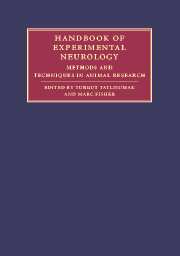Book contents
- Frontmatter
- Contents
- List of contributors
- Part I Principles and general methods
- Part II Experimental models of major neurological diseases
- 18 Focal brain ischemia models in rodents
- 19 Rodent models of global cerebral ischemia
- 20 Rodent models of hemorrhagic stroke
- 21 In vivo models of traumatic brain injury
- 22 Experimental models for the study of CNS tumors
- 23 Experimental models for demyelinating diseases
- 24 Animal models of Parkinson's disease
- 25 Animal models of epilepsy
- 26 Experimental models of hydrocephalus
- 27 Rodent models of experimental bacterial infections in the CNS
- 28 Experimental models of motor neuron disease/amyotrophic lateral sclerosis
- 29 Animal models for sleep disorders
- 30 Experimental models of muscle diseases
- Index
- References
27 - Rodent models of experimental bacterial infections in the CNS
Published online by Cambridge University Press: 04 November 2009
- Frontmatter
- Contents
- List of contributors
- Part I Principles and general methods
- Part II Experimental models of major neurological diseases
- 18 Focal brain ischemia models in rodents
- 19 Rodent models of global cerebral ischemia
- 20 Rodent models of hemorrhagic stroke
- 21 In vivo models of traumatic brain injury
- 22 Experimental models for the study of CNS tumors
- 23 Experimental models for demyelinating diseases
- 24 Animal models of Parkinson's disease
- 25 Animal models of epilepsy
- 26 Experimental models of hydrocephalus
- 27 Rodent models of experimental bacterial infections in the CNS
- 28 Experimental models of motor neuron disease/amyotrophic lateral sclerosis
- 29 Animal models for sleep disorders
- 30 Experimental models of muscle diseases
- Index
- References
Summary
Introduction
The purpose of this chapter is to provide a brief synopsis of bacterial meningitis and brain abscess and the animal models used to study these diseases and evaluate potential therapeutic modalities. The reader is encouraged to consult the selected references for more detailed information.
Bacterial meningitis
Despite advances made in vaccination and treatment strategies, bacterial meningitis remains associated with a significant mortality rate and incidence of neurological sequelae, particularly in very young and elderly patients. Approximately 1.2 million cases of bacterial meningitis are estimated to occur worldwide annually with 135 000 deaths. Long-term effects resulting from meningitis include hearing loss, hydrocephalus, and sequelae associated with parenchymal brain damage including memory loss, cerebral palsy, learning disabilities, and seizures. Organisms that colonize the mucosal membranes of the nasopharynx include Neisseria meningitidis, Streptococcus pneumoniae, and Haemophilus influenzae which are the leading etiologic agents of community-acquired meningitis. Recurring bacterial meningitis epidemics, the emergence of antimicrobial resistance among many meningeal pathogens, and the failure to introduce the H. influenzae conjugate vaccines (Hib) into many developing countries all contribute to bacterial meningitis remaining a serious global health problem.
Bacterial meningitis elicits a complex myriad of pathophysiological changes that present numerous obstacles when considering the design of therapeutic strategies. For example, besides the direct damage induced by pathogens, the host antibacterial response elicited during the acute phase of bacterial meningitis can be detrimental to neurons and other glia in the central nervous system (CNS) due to the toxic effects of cytokines, chemokines, proteolytic enzymes, and oxidants produced locally at the site of infection.
- Type
- Chapter
- Information
- Handbook of Experimental NeurologyMethods and Techniques in Animal Research, pp. 472 - 486Publisher: Cambridge University PressPrint publication year: 2006



